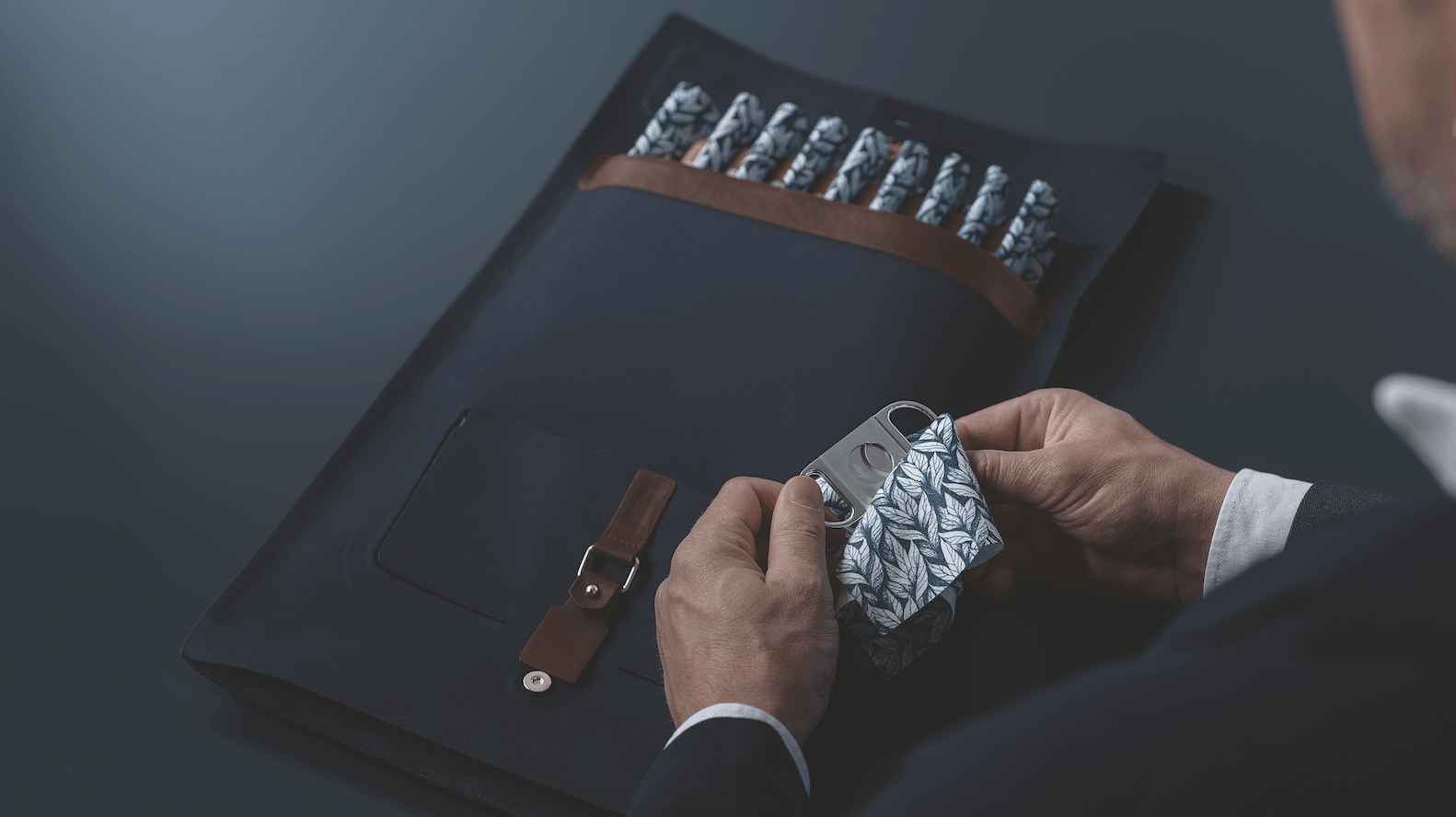DAVIDOFF: THE STORY OF A LEGEND

To enrich their collections and supplies, many cigar lovers and collectors are always on the lookout for rare cigars or cigars that have been taken out of production. One brand whose cigars are highly sought after is Davidoff, and especially the Havana cigars from the production period in Cuba. Zino Davidoff was born in 1906 in a small town in Ukraine. In 1911, his family decided to emigrate to Switzerland, more precisely Geneva. There, his father, who had been working in the tobacco business for several years, decided to open a small shop that sold cigarettes and pipes. When Zino came of age, he decided to go to South America to learn more about the magical world of tobacco. After working in small factories in Argentina and Brazil, he travelled on to Cuba, where he was intensely involved with the cultivation of tobacco and the production of cigars. In 1930, he returned to Geneva, where he quickly realized that the climate in which the cigars that were made and stored in Cuba was fundamentally different from that of Europe. For this reason, after a few years in his modernized shop in Rue de la Confédération he built a humidor, which then allowed him to store cigars in the most preferable and aroma-sustaining conditions as possible. It was the first ever humidor, thus making Zino Davidoff the inventor of this important utensil for the passionado. A few months after the outbreak of World War II, 1939 Zino Davidoff received an interesting offer from Seita, the French tobacco monopoly. In view of the precarious security situation in France, he was made the offer of purchasing two million Havana cigars. Zino didn’t let this opportunity pass him by, even though he had to secure financial support from a bank. His shop, now in Rue de Marché, thus became one of the few in the whole of Europe in which one could purchase cigars during World War II. After the end of the war, in 1946 Davidoff arranged a meeting with a Cuban delegation to find out whether it was possible to launch exclusive production for himself and his clients. This is how the production of the Château series began with the Hoyo de Monterrey brand, also called Premier Cru Classé. However, the cigars were no longer sold in the then beautiful colorful boxes but in boxes of untreated wood.
(Coronas Grandes 155 x 16.7 | 6 1⁄8 x 42). In the mid-1980s, the name of another cigar was also changed: the Château Lafite became the Château Lafite-Rothschild. It was also rumored that the name change of these two cigars was due to a legal dispute about the use of the name.
The entire Château series continues to be produced in the La Corona factory. In 1986, on the occasion of Zino Davidoff’s 80th birthday, a majestic cigar was presented: the 80 Aniversario (220 x 19.1 | 8 5⁄8 x 48). This vitola de galera was also never declared and is still unknown today.
For this limited edition in the literal sense of the phrase, different packaging was provided. The first cabinet features an elegant opening like a book and contains 10 cigars, two of which are in cedar tubes. The second cabinet, a box with a sliding lid, also contains 10 cigars, but these are all preserved in cedar cases and lined up in two rows of five cigars each. Finally, there is the version with 20 cigars, likewise with an opening like a book, and these also contain two cigars in cedar tubos, while the others are lined up in a single row. Davidoff cigars became more and more popular, and demand for them increased accordingly. Nevertheless, after a few years Zino Davidoff became increasingly dissatisfied with his cigars, because there were problems with the draw and burn, which was not ideal. The high quality that had hitherto distinguished the manufacture of Davidoff thus suffered losses. In 1989, together with representatives of Cubatabaco and Swiss customs officials, Zino Davidoff set fire to about 130,000 Havana cigars. Due to disagreements with Cubatabaco, the production of Davidoff cigars in Cuba ceased in 1991 and the parties signed an agreement to sell the remaining supply by the end of 1992. At that, production was then moved to the Dominican Republic – but that’s another story. To this day, Davidoff’s Habano cigars are highly coveted among collectors from all over the world and obtain extremely high prices at cigar auctions. Even today, we are grateful to Zino Davidoff, who left us in 1994, for his life’s work, which has made it possible to enjoy unique, high-quality cigars. And in honor of thisIn total, the series consists of five different vitolas: a Château Haut -Brion (Perlas* 102 x 15.9 | 4 x 40), Château Lafite (Franciscanos 116 x 15.9 | 4 5⁄8 x 40), Château Margaux (Marevas 129 x 16.7 | 5 1⁄8 x 42), Château Latour (Coronas 142 x 16.7 | 55⁄8×42), Château Yquem(152 x 16.7 | 6 x 42). The vitola de galera of this last cigar was never officially declared and is still unknown. Zino Davidoff’s idea of giving his cigars the name of great French wines proved to be an important innovation for the cigar market. All cigars from the Château series were sold in a slide-lid box (SLB) with 25 or 50 cigars without rings. In 1969, a few years after the meeting between Cubatabaco and Davidoff executives, the first three proposed vitolas of the Davidoff brand were presented: the No.1 (Laguito No.1: 192 x 15.1 | 7 1⁄2 x 38), the No.2 (Laguito No.2: 152 x 15.1 | 6 x 38), and the Ambassadrice (Laguito No.3: 115 x 10.3 | 4 1⁄2 x 26). They were all produced in the El Laguito factory. The cigars produced were decorated with a white ring, on which the brand was emblazoned with gold lettering in the middle. On the side are the words “Habana” and “Cuba.” In 1970, Davidoff introduced a new series, Mille, with five formats: the 1000 (Panetelas 117 x 13.5 | 4 5⁄8 x 34), the 2000 (Marevas 129 x 16.7 | 5 1⁄8 x 42), the 3000 (Ninfas 178 x 13.1 | 7 x 33), the 4000 (Co- ronas Grandes 155 x 16.7 | 6 1⁄8 x 42) and, finally, the 5000 (Coronas Gordas 153 x 18.3 | 6 x 46). In 1977, a certain cigar went down in the history books – because of both its proposed dimensions and its name: the Dom Perignon. The cigar is a Julieta No.2 measuring 178 x 18.7 | 7 x 47. It was presented in a Semi Boîte Nature (SBN) of 10 to 25 sticks and in petacas with four cigars each. Zino Davidoff also used this opportunity to christen his cigar with a name of French excellence, this time inspired by one of the best champagnes in the world. In addition to this, Zino Davidoff introduced innovative packaging, which should be mentioned here: the No.2 was also marketed as Davidoff Tubos, since the SBN contained 20 tubos made of aluminum. The special feature is that, due to a slot in the tubos and by turning this special packaging, air circulation is allowed to pass through and the cigars inside can be ventilated in an ideal way. In 1982, the Château Yquem series was discontinued and shortly afterwards, in 1983, another cigar for the Château series was introduced: the Mouton Rothschild

























